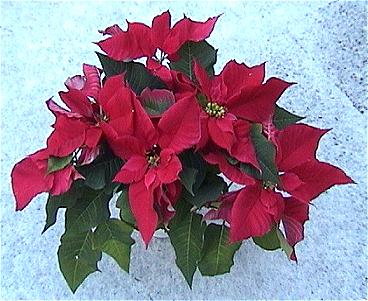

Kerstster - Poinsettia - Euphorbia pulcherrima (Euphorbiaceae)

|
Deze plant, ook wel Poinsettia genoemd, is eigenlijk alleen met kerst te koop - en dan ook
massaal. Er zijn ook (groenig)witte en roze exemplaren, maar deze zijn sterk in de minderheid, de rode zijn sprekender van kleur en ademen meer "kerstsfeer". | You can only buy this plant, also called Poinsettia, around Christmas - and they've got masses
in the shops by that time. Greenish-white and pink ones also exist, but they're less popular, the red ones are more striking and give more "christmas-feeling". |


| De plant staat hier voor de foto in de sneeuw, maar kan beslist niet tegen lage temperaturen - de vensterbank is een betere plek. | The snow is only a pretty background for this plant, which absolutely can't stand low temperatures - the window-sill is a better place. |


|
In het "hart" van de kerstster staan de eigenlijke bloemen, in een bloeiwijze bij elkaar; de rode bladeren zijn nog steeds blad, maar
met een contrasterende kleur om de aandacht op de bloemen te vestigen. Deze manier van bloeien vindt men bij meer Euphorbia's, bijv. de Christusdoorn (E. milii). De plant heeft ook het typische melksap, dat deze plantenfamilie ("Wolfsmelk") kenmerkt. | Only the "heart" of Poinsettia consists of the actual flowers - the red leaves around it still
are leaves, only contrasting to draw attention to the flowers in the middle. This way of flowering is found in more Euphorbias, e.g. E. milii. The plant also contains milky juice, a typical quality of Euphorbiaceae (spurges). |

| Op het subtropische eiland Madeira, waar het nooit vriest, groeit de plant buiten in tuinen en parken. Het kan een behoorlijke struik worden, met een dikke houtige stam (hieronder), en met veel grotere bloemen dan de exemplaren die wij in de winkel kopen (zie foto hierboven). | On the subtropical island of Madeira, with temperatures never below zero, the plants grow outside in gardens and parks. It can become quite a bush with a woody trunk (below) and flowers that are much bigger than those of the plants we buy in the shops (see photo above). |


| De plant is meestal moeilijk weer in bloei te krijgen een volgend seizoen. Buiten in een warm klimaat gaat het vanzelf, maar de planten die wij met kerst kopen hebben op de kwekerij een "korte-dag-behandeling" gehad om in bloei te komen. Ze kunnen wel jaren in leven blijven, maar nadat de rode bladeren zijn afgevallen (ze kunnen er overigens wel een maand of vier aan blijven zitten) blijft er weinig moois over, meestal groeit de vorm er ook helemaal uit. | Although the plants we buy for Christmas may live for years, they're not likely to flower again after the first season. They're given a short-day-treatment in the nurseries to get them flowering around Christmas. The red leaves may stay on the plant for about 4 months, but afterwards you've got a rather dull green plant, that gets more and more out of shape. The plants living in subtropical climates don't have this problem, of course. |

